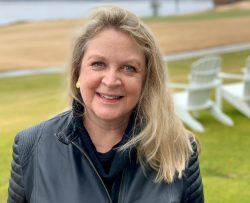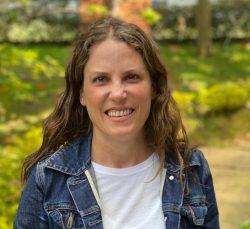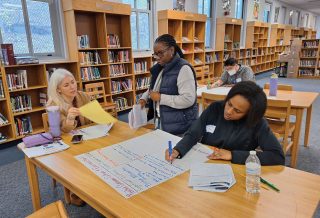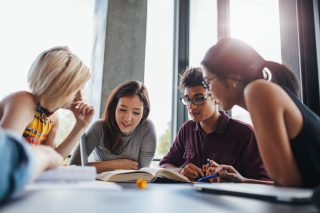FOCUS
ONLINE EXCLUSIVE: Bilingual program builds a bridge to equity
By Barbara Noel, Maria Patricia Mesa and Vanessa Gilchrist
Categories: Early education, English learners, International perspectives, Learning communities, Learning systems/planningApril 2021
If you were to walk through our international school campus, built on a verdant mountain overlooking Bogotá, Colombia, you would most likely hear our 1,800 students speaking a mix of English and Spanish. As of 2021, 80% of our students are nonnative English speakers representing 47 nationalities.
Parents enroll their children into Colegio Nueva Granada because it is a U.S.-oriented college preparatory institution accredited by U.S. and Colombian educational agencies. About 45% of graduates move on to study at U.S. universities, 30% choose Colombian universities, and the remaining students choose universities in other parts of the world.
English acquisition is a main goal of the school, and it is clearly attractive for parents who see this as a pathway to academic success and professional opportunity for their children. This typically means that all preschoolers, starting at age 4, begin formal schooling immersed in English, a language that is entirely new to most of them, with only 45 minutes of instruction in Spanish daily in grades pre-K-5.
To build students’ ability to communicate in English, the school has invested in a rigorous workshop-style literacy program and provided extensive technical training and support for teachers and coaches to implement it. This has involved sending teachers, administrators, and coaches abroad for extended training and bringing in staff developers for lesson demonstrations, microlabs, and curriculum alignment to ensure that the program is implemented with fidelity.
After almost a decade of this investment, the school has significantly raised students’ English and Spanish literacy levels. According to the school’s annual report (Colegio Nueva Granada, 2017), overall reading performance moved up six percentile points from 2010 to 2016 on the Measures of Academic Progress test. Similar patterns emerged on the English language usage subtest. Data for 2016-20 follow the same trend. Likewise, standardized test results for Spanish language arts called SABER grade 3 and SABER grade 5 show that our students significantly outperform similar schools in Bogotá.
But our school still has important work to do to continue its upward trajectory, particularly around building equity. In recent months, we have been working to move the Spanish and English programs from being two separate worlds into one that is now more purposefully coordinated in a coherent and equitable manner. Professional learning is at the center of that work.
Building equity in literacy
The school recently updated its mission to reflect a higher value for diversity, equity, and respect for Colombian culture, and we wanted to ensure our literacy practices aligned with this focus. Additionally, teachers and parents said that, while English development is clearly important, so, too, is the need to equally value Spanish development both as a base for literacy in general and as a way to strengthen students’ cultural identities. We grew in our understanding that when we embrace the child’s language, we also embrace the whole child. This coincided with a growing research base indicating that language, literacy, and learning are greatly enhanced when learners are solidly literate in their home language (August & Shanahan, 2006; International Literacy Association, 2019).
As these strands converged, we realized that our approaches to literacy in English and Spanish were not equitable, and we knew we needed to change that. In pre-K to grade 5, all students receive instruction in English and Spanish, but, historically, most of the literacy block was taught in English to all students. We recognized that we needed to question and reflect on this. We decided that we needed to more clearly define the role of Spanish in our school, coordinate the Spanish literacy programs for native speakers and for students for whom Spanish is a new language, and create more alignment between English and Spanish instruction.
This meant addressing several structural barriers. Until recently, Spanish teachers taught the same literacy units as the English program, but in less than half the time while also integrating Colombian social studies. They had little planning time because they taught inside of the English homerooms and had to race between classrooms. They also used different data collection sources and systems than English teachers. Similar discrepancies were found between the primary and elementary schools.
A culture of professional learning
To create more alignment across languages and grade levels, we have dedicated ourselves to collaborative professional learning. To begin, our senior leadership invited educators from across buildings and programs to engage in meaningful conversations about literacy practices in both languages and how to build bridges between them. Faculty represented primary school (pre-K to grade 2) and elementary school (grades 3 to 5) as well as English, Spanish, Spanish as a new language, and Learning Center programs
It was a time of reflection, acknowledging one another, and bringing to the table assumptions that have historically divided us. One of those assumptions was that more instructional time in English led to accelerated English language acquisition, a belief that led to Spanish taking up as little time as possible in the schedule. Another observation was that instructional practices differed and needed alignment. These honest conversations were not easy; some resulted in tears. But they were important for building bridges — and not just the bridge models we built with fettuccine and marshmallows during a learning exercise.
As these conversations evolved, we formally established a professional learning community (PLC) and defined our work as follows: To build a thorough understanding of biliteracy and how it encourages diverse, equitable, and inclusive learning to develop students’ individual potential as global, intercultural, and bilingual citizens. We aimed to construct a shared, research-based understanding of biliteracy as well as pilot tools for comparing language features, a plan for coordinating units across languages, and methods of assessing literacy skills in both languages in an integrated manner. We gathered 30 homeroom teachers, Learning Center specialists, Spanish and Spanish as a New Language teachers, administrators, and biliteracy coaches for meetings every other week. We followed a variety of protocols aimed at opening opportunities for research, action, and reflection and explored strategies and concepts from professional readings (Escamilla et al., 2014; Lara, 2017).
It quickly became evident that much unites our practices across language programs and school sections, but we also saw differences that we needed to address. We have begun with the following steps.
Aligned structures:
- Align the Common Core State Standards used in English with those required by the Colombian Ministry of Education.
- Create the same assessment tools across languages to calibrate writing.
- Redesign schedules to allow for common planning time between English homeroom and Spanish teachers.
Intentional staffing:
- Redefine the instructional coaches’ titles to biliteracy coaches.
- Hire two new primary school Spanish teachers to ensure that two Spanish teachers were at each grade level from pre-K-5.
- Form grade-level teams that aim to integrate Spanish teachers into the core grade-level teams.
- Hire an assistant national program director for the Spanish program.
- Provide three classrooms specifically for Spanish classes in elementary school.
In addition, we have prioritized coordinated and collaborative professional learning and capacity building for all instructional staff. Leaders and PLC members decided to continue our early literacy PLC into a second year and work toward a greater representation of members across grades and programs.
Moving ahead
Four months later, these actions have already created positive impacts for students. Through online Zoom sessions, we asked the 30 members of the group what they have been noticing and want to keep nurturing. Their responses can be grouped into the following categories:
From fragmentation to coherence: Coherence for student learning emerges when teachers share standards, assessments, practices and strategies across language programs and school sections. Aligned standards guide learning for both the English and Spanish programs, enabling teachers to see the whole child and not just the English or Spanish child in their program. Vertical teams are integrating teachers across both languages and both primary and elementary school sections. As a result, students understand content better. They generate higher-quality ideas through bilingual brainstorming. They make more emotional connections in their literacy experiences.
From silos to integration: Languages complement each other throughout the literacy program when teachers co-plan units and lessons across languages. Anchor charts comparing the language features of both languages and bilingual word walls appear more frequently. Coaching cycles with the same learning targets are being used across language programs. Teachers see student skills and ways of thinking growing more evenly between both languages. They also see higher levels of student engagement. Likewise, parents see that their children are more motivated to write and share their learning.
From a monolingual lens to a multilingual lens: Parity in the value of both languages and cultures honors student identities in learning. More Spanish resources are showing up around the classroom. Thus, students are growing more stamina and interest in reading in Spanish. Students are using their linguistic resources to express themselves with more fluency and frequency.
From old habits to clear purposes: Equity in practice grows as teachers purposefully plan when and how to use both languages. Teachers justify their choices for which language to use based on intentional pedagogical purposes. This, at times, looks like introducing new concepts in a student’s home language before transferring to the new language. At other times, the new language might be used and the home language is brought in at a later time to ensure balanced growth. Additionally, as the need arises, teachers may use a student’s home language to address emotional concerns. This leads to greater depth of understanding and clarity, especially with pre-K students.
These positive impacts provide a more robust program for our students. They also show teachers that investing in hard conversations can be deeply rewarding.
Moving into our second year, our PLC will focus on adaptive capacity — building on what’s working, visualizing new scenarios, trying out new practices and reflecting on them, and embedding collaboration and inquiry throughout our work together.
As we move forward, staff from multiple domains and grade levels gain mutual appreciation and learn together. When educators commit to collaboration, teachers and students make meaningful progress toward equity.
6 linchpins for adaptive change
Our work in the second year of our PLC is based on a framework for collaborative inquiry that can be described around six linchpins for adaptive change (Donohoo & Velasco, 2016). They are:
- Voluntary participation. All biliteracy coaches, Learning Center specialists, teachers, and administrators are invited, not mandated, to be involved, and participation is based on commitment versus a sense of compliance to management.
- Shared leadership. The director and associate director for learning & teaching initiated and support this work. Their involvement and collaboration was pivotal for building the necessary trust to open up sincere conversations among teachers. Responsibility has now passed to the primary and elementary school principals and the national program director who oversees the Spanish program. The biliteracy coaches have also been invited to lead because their role is critical in supporting sustainable change through an inquiry and data-informed stance.
- Guided from experience. We relaunched our PLC from an appreciative inquiry orientation to re-establish trust and build from the solid experience, skills, and talents of our group members. We began by exploring teachers’ observations, dreams, and discoveries of what is already working well. Therefore, we are starting our inquiries on an asset-based vs. a problem-solving stance.
- Achieved coherence. While senior leadership initiated the school improvement process in a top-down manner, responsibility and ownership have now shifted to teachers through an organic, grassroots process. We are forming inquiry teams based on teacher questions about their own classroom practices. In this way, we achieve a balance between institutional and teacher-driven interests.
- Learning is recognized and disseminated. We communicated the results from the first year of the PLC to the entire school community. This led the teachers toward greater engagement with the purpose and vision of the PLC because it honored the balance of top-down and bottom-up processes of change. This ought to continue as the collaborative inquiry cycles reach shareable conclusions.
- Skilled facilitation. We have followed a nested model of support to promote greater chances of success. At first, an outside consultant worked mostly with senior leadership. Ownership passed to the primary and elementary school principals and the national program director. The consultant facilitates planning meetings, orients the leadership team, and monitors the participation of the larger PLC team. This allows the principals and director to focus on facilitating the meetings. The biliteracy coaches, in turn, work directly with the inquiry teams to apply new practices and push thinking as teachers critically analyze impacts on student learning. This depth of support promises to enable our professional learning to spread across the community and improve sustainable change processes.
References
August, D. & Shanahan, T. (2006). Developing literacy in second-language learners: Report of the national literacy panel on language-minority children and youth. Lawrence Erlbaum Associates.
Colegio Nueva Granada. (2017). Annual report 2016-2017. Author.
Donohoo, J. & Velasco, M. (2016). The transformative power of collaborative inquiry: Realizing change in schools and classrooms. Corwin Press.
Escamilla, K., Hopewell, S., Butvilofsky, S., Sparrow, W., Soltero-Gonzaléz, L., Ruiz-Figueroa, O., Escamilla, M. (2014). Biliteracy from the start: Literacy squared in action. Caslon Publishing.
International Literacy Association. (2019). The role of bilingualism in improving literacy achievement. Author.
Lara, M. (2017). ¡Toma la palabra! Seidlitz Education.
Categories: Early education, English learners, International perspectives, Learning communities, Learning systems/planning
Recent Issues
LEARNING DESIGNS
February 2025
How we learn influences what we learn. This issue shares essential...
BUILDING BRIDGES
December 2024
Students benefit when educators bridge the continuum of professional...
CURRICULUM-BASED PROFESSIONAL LEARNING
October 2024
High-quality curriculum requires skilled educators to put it into...
LEARNING TO PIVOT
August 2024
Sometimes new information and situations call for major change. This issue...















